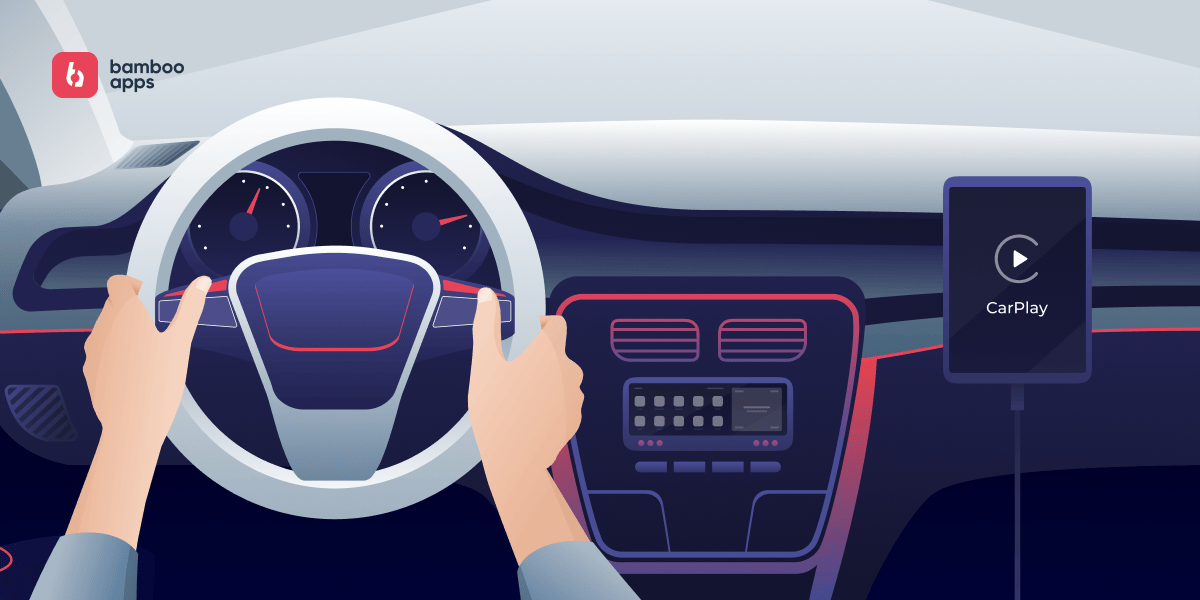- Introduction
- Understanding CarPlay, beyond the basics
- App categories suitable for CarPlay
- Getting started with Apple CarPlay app development
- The business case for a CarPlay app
- Adapt your app with the help of an Apple CarPlay developer
- Conclusion
Introduction
Imagine your app becoming an indispensable companion for every drive. With over 800 models of vehicles that support CarPlay in 2024, the potential audience for it is huge – and it is constantly growing. Apparently, most car buyers do not want a native system, and one-third of consumers say they will not purchase a car if it lacks integration with their smartphone.
CarPlay is a fantastic platform for creating software that transforms the driving experience. It allows for building apps that make every journey safer, more fun, and convenient. From finding your way to jamming out to your favourite tunes, the possibilities are endless.
In this article, Bamboo Apps invites you to shift gears into CarPlay app development mode.
Understanding CarPlay, beyond the basics
There may be a perception that CarPlay is only capable of playing music and providing navigation. In fact, it can do much more than that. Bamboo Apps’ CarPlay experts look at its core features and architecture, as well as explain design guidelines, to discover overlooked elements.
Core features
Siri integration
It is hard to imagine an iOS-fuelled system without its faithful companion, Siri. This intelligent voice assistant is a crucial tool for a hands-free driving experience. Siri eliminates the need to look away from the road or touch your phone and offers convenient ways to access information. Well-loved apps like Google Maps, Waze, and Spotify all have Siri integration.
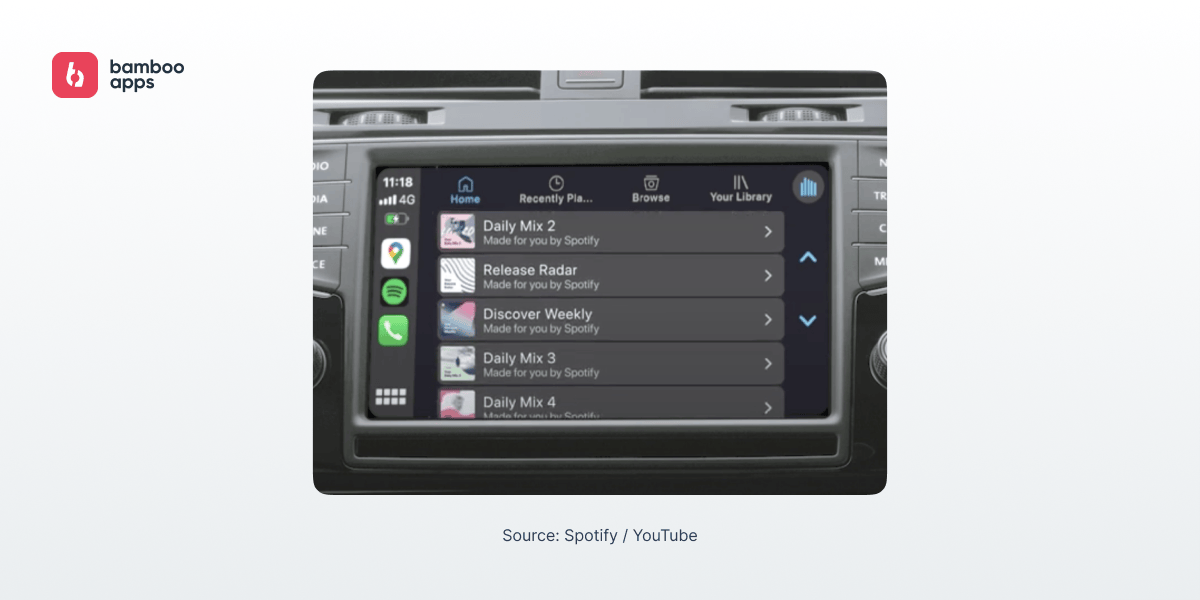
Phone calls
CarPlay is all about simple, safe calling on the road. It lets drivers chat hands-free using Siri or the touchscreen. You can see who is calling on an easy-to-read display, and you may answer or decline with a single tap or voice command. To fit right in, your app needs to work seamlessly with CarPlay’s call features.
Maps
In the realm of CarPlay, maps are the ultimate copilot. They act as your reliable guide, taking you from point A to point B with ease. CarPlay maps have easy-to-use interfaces that help you concentrate on the road. You may easily follow directions, find new routes, and locate nearby stops like restaurants, coffee shops, and petrol stations with a quick check at the car’s display.
Music
There cannot be a proper driving experience without music. CarPlay puts your music library right at your steering wheel. You are in total control of the music, whether it is selecting your preferred playlist or finding new artists. Music apps are among the most popular on CarPlay.
Third-party app support
Third-party app support means drivers do not have to compromise on their preferred iOS apps just because they are driving. Essentially, this feature makes CarPlay a personalised and convenient driving companion. It allows developers to reach a wider audience of users by enabling the development of specialised apps, audiobooks, and messaging services.
CarPlay architecture
CarPlay is Apple’s standard that allows drivers to connect their iPhones to the car’s infotainment system and use apps and features on a larger screen. There is support for both wired and wireless connections, via a Lightning cable or using Wi-Fi or Bluetooth. Then, the head unit receives the CarPlay interface from the iPhone. Using the controls in the car, the driver engages with it.
User input is sent from the head unit to the iPhone, which interprets it and reacts appropriately. The head unit receives audio, video, and other content from the iPhone and plays it back.
To sum it up, the iPhone functions as the central processing unit while the head unit of the car functions as an external display and input device.
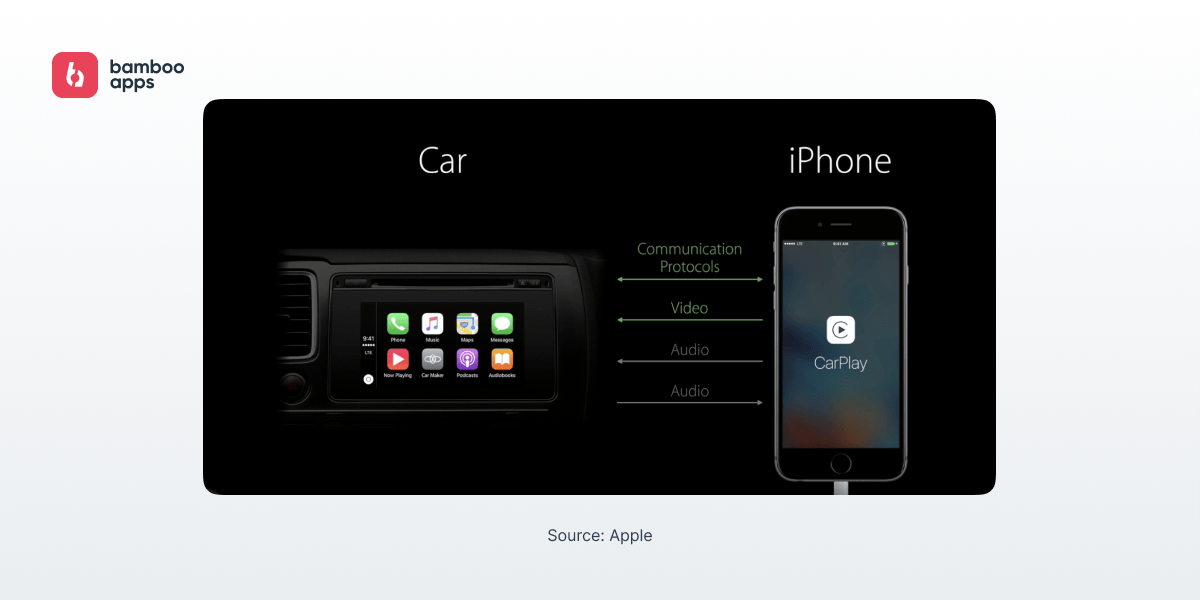
Design guidelines
According to CarPlay’s design guidelines, known as the CarPlay App Programming Guide, all applications for the standard must follow a prerequisite set of rules:
- Every CarPlay app needs to be designed with the primary goal of giving the user access to the designated feature.
- Apps should never instruct users to pick up their phones.
- No user flow in CarPlay should require iPhone interaction.
- Every CarPlay user flow needs to make sense to operate while driving.
- Your application should not fall into any of these categories: social media and gaming.
- Never use the CarPlay screen to show the contents of emails, texts, or messages.
- Utilise templates for what they are designed to do, and only add the appropriate kinds of content to them.
- All voice communication needs to be done through SiriKit.
In addition, CarPlay does not display certain types of content, such as song lyrics.
You can read the original document here.
App categories suitable for CarPlay
The guide in the section above clearly defines the categories allowed for CarPlay development. CarPlay allows you to use the following kinds of apps in addition to calling, sending and receiving messages, listening to music, and getting directions:
- Audio
- Communication (messaging and calling)
- Driving task
- EV charging
- Fueling
- Navigation (turn-by-turn directions)
- Parking
- Quick food ordering.
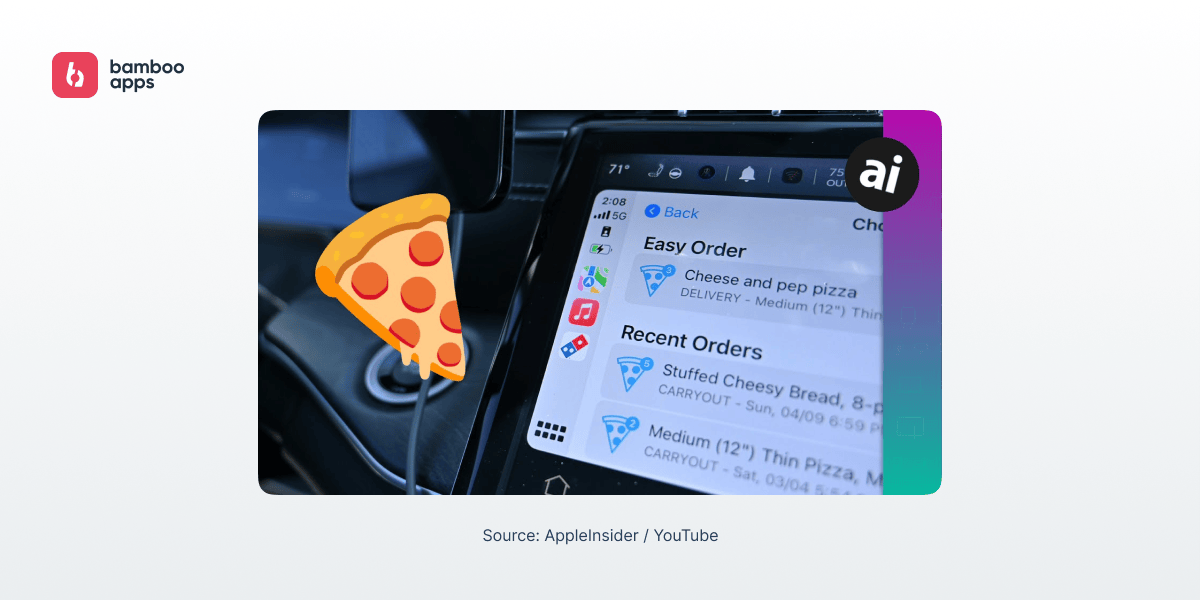
Getting started with Apple CarPlay app development
Now that we know about CarPlay architecture and design guidelines, we may get behind the wheel to create a CarPlay app. Where do we start? In this section, we will look at some of the most important things an Apple CarPlay developer should know.
UI limitations of CarPlay apps
CarPlay is a strong platform, but it has certain UI limitations to maintain driver’s safety. Here are the things you should keep in mind when you develop iOS CarPlay apps:
- All applications must be designed to keep driver distraction to a minimum.
- Apps should have simple, easily scannable interfaces with large touch elements.
- To guarantee consistency and clarity in the UI, developers must follow certain templates.
- Certain manufacturers limit the use of touchscreen features when the vehicle is moving.
Tailoring design to the driving environment
Apple’s idea behind CarPlay is to give drivers the information and tools they need without distracting them from the road – CarPlay apps should not encourage drivers to have prolonged interactions with the infotainment system. As an alternative, they should provide information clearly and concisely so the drivers can keep their focus on the road.
Voice command optimization
Voice command optimization for applications is crucial. Apple developers should integrate Siri using Sirikit so that drivers can use voice control to complete activities – without having to touch or look at the screen.
Importance of replicating car environments for app testing
If you want your CarPlay app to feel natural and operate without a hitch, you should replicate car environments for testing to try to capture all the bumps, distractions, and controls of a real drive. The CarPlay Simulator is a safe choice for testing as it offers about the same functionality as actual CarPlay. However, Apple advises you to test your app in a real vehicle or with an aftermarket system as well. It is important for a number of reasons:
- Meaningful user experience. Developers can achieve a true user experience when testing iOS CarPlay apps in real vehicles, something that simulators cannot truly imitate.
- Recognising usability issues. It is possible to find usability problems in a real car that would not be noticeable in a simulation setting. For instance, to reduce distractions while driving, an Apple CarPlay developer might assess how simple it is to use the app.
- Safety points. It goes without saying that safety is critical for any driving app, and testing in a vehicle enables developers to put safety first. This, for example, involves assessing the app’s integration with Siri’s voice commands to make sure drivers can engage with it without physically manipulating their phones.
- Performance assessment. Real-car testing allows developers to evaluate how well their apps work in different driving scenarios, such as distractions, and test audio quality and response times.
Alex Levshenkov, Senior iOS App Developer at Bamboo Apps, shares his own opinion on the matter:

“As an app developer, I can confidently say that nothing beats testing your CarPlay application in an actual car. Although excellent for first use, simulators such as the iOS Simulator and the CarPlay Simulator are unable to accurately recreate the experience of using the app while driving. Testing in a real car offers priceless insights into the app’s usability, audio quality, and distractibility of the app. These are all essential components for guaranteeing a flawless user experience.”
Peculiarities of CarPlay app development
Submitting an app to Carplay requires following a defined process that guarantees adherence to Apple’s principles and regulations.
First of all, you should verify your app’s compatibility with the Apple-approved categories for CarPlay (see above). The application’s primary purpose must be to offer a specific feature that is relevant to driving operations.
The next step is obtaining CarPlay entitlement. Submit a detailed CarPlay app entitlement request through Apple’s developer portal, agreeing to the CarPlay Entitlement Addendum. Apple will review and approve or deny the request, assigning the entitlement to your developer account if successful.
After obtaining the entitlement, establish your CarPlay development environment. This entails integrating a CarPlay-specific app delegate and adding the CarPlay framework to your current app.
Next up, testing and debugging. Test the CarPlay experience in detail, paying special attention to how the app responds to calls and other CarPlay activities.
Then, after the development and testing stages are completed, submit your app for evaluation via App Store Connect. It will go through a review process to ensure compliance with all of Apple’s requirements and functionality standards for CarPlay apps. Your CarPlay app will be available for download from the App Store following approval.
The business case for a CarPlay app
With an increasing desire for in-car entertainment, information, and convenience, CarPlay represents an interested audience. Your CarPlay app can turn into a lucrative venture, capturing the audience en route and driving revenue.
How to monetise your CarPlay app
There are several ways of making money on your CarPlay app. The key here is to offer features that drivers are ready to pay for.
In-app purchases are the most popular way of monetising your app. CarPlay applications can include this type of purchase to unlock more features or content. For example, podcast apps may offer individual episodes for sale as in-app purchases.
Subscriptions for ongoing content and freemium models are particularly effective for CarPlay apps. Think Spotify and its premium subscriptions for offline and ad-free listening. Audiobook apps like Audible can offer a book or two for free and then switch to a subscription for a set amount of audiobook credits.
Collaborating with brands and businesses to provide sponsored content is an additional profitable prospect. For example, a navigation app sponsored by a nearby restaurant or petrol station may offer recommendations. This generates income while improving the user experience.
Last but not least is the case of data monetisation. Applications that gather information on user preferences, driving habits, and routes taken might make money by selling the insights they get to third parties. Businesses and governments can obtain traffic analytics and route optimization services from companies like INRIX, which use data from connected vehicles to generate income through subscription-based access to their data services.
However, it is extremely important to remember that collecting any user data by an app, especially for the purpose of generating revenue, must begin with an explicit request for user consent to all such activities.
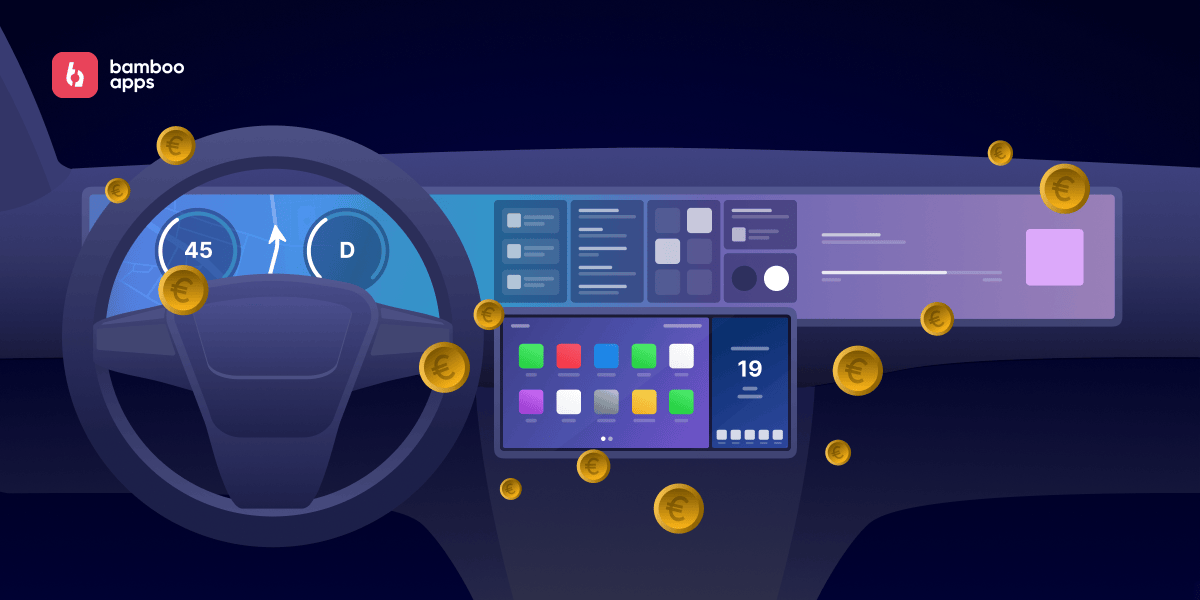
Utilising in-car data for business intelligence
Even though CarPlay does not provide you a direct peek inside your car’s details, it can nevertheless give you important information about how users interact with your app while driving. Making better business decisions and forming beneficial collaborations can be aided by knowing what users do with your app when operating a vehicle. You can improve the entire app experience or generate new revenue streams by examining how frequently features are used, when users use your app the most, and what they prefer.
Adapt your app with the help of an Apple CarPlay developer
To create a CarPlay app, your development team needs to have a distinct set of abilities to satisfy Apple’s requirements and provide a genuinely intuitive driving experience. Alternatively, you may invite an experienced tech partner or an app studio on board to benefit from their expertise in CarPlay development.
At Bamboo Apps, we specialise in designing and developing unique software solutions for the mobility and automotive industries. One of our most innovative projects that supports CarPlay is IVO, a unique in-vehicle onboarding system. The infotainment app gives drivers real-time relevant suggestions and recommendations, while the mobile application provides a complex augmented reality (AR) tour, allowing the driver to learn about the vehicle’s controls and units.
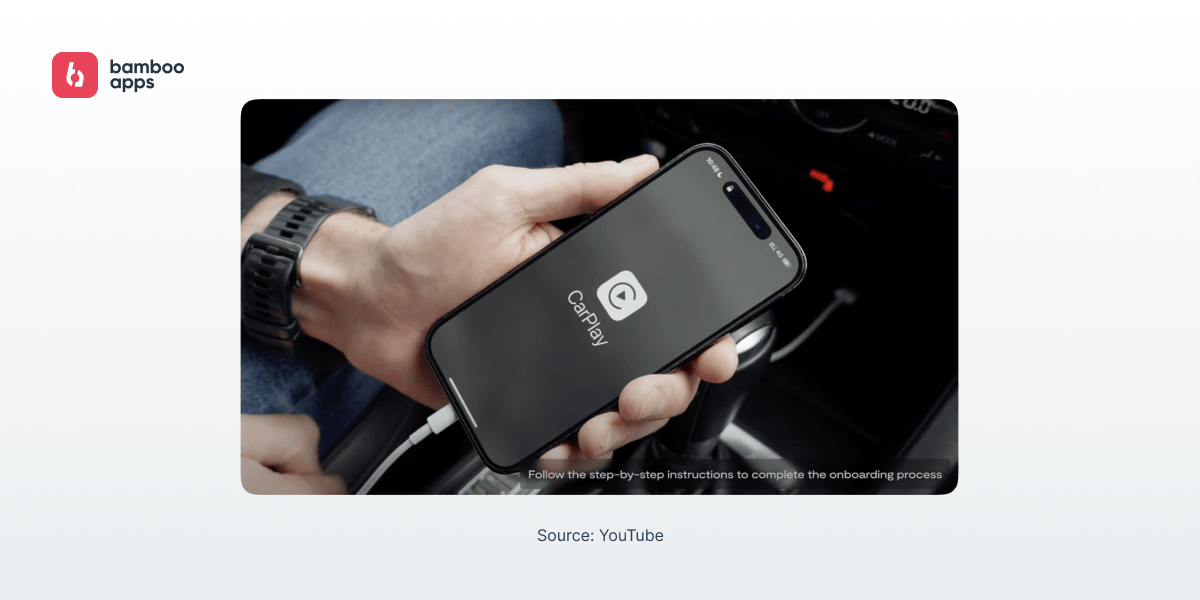
Conclusion
There is a lot of potential ahead once you start developing CarPlay apps. Apple CarPlay is a great tool for meaningfully engaging people because of its capacity to improve driving experiences and its expanding reach. You can create a CarPlay app that delights users on their journeys and becomes a profitable venture for you. What you need is to learn about the nuances of CarPlay architecture, follow Apple’s strict design guidelines, and thoroughly test your app in real-world driving conditions.
Meanwhile, our team at Bamboo Apps is available to assist you at every stage of the process, regardless of your level of experience with CarPlay. Drop us a line – and have a great journey into CarPlay development.
